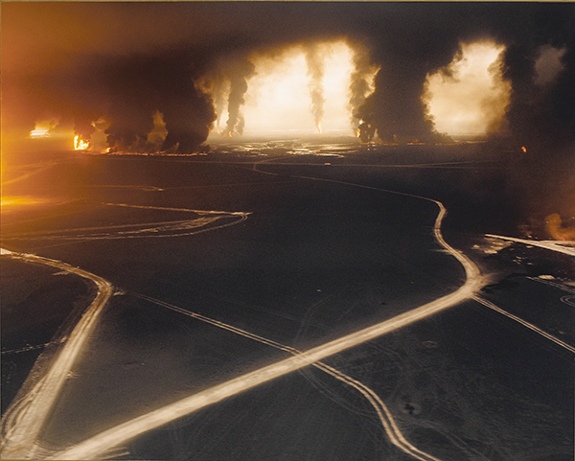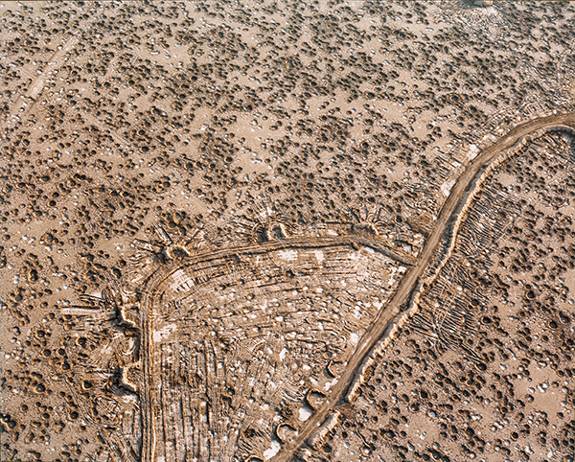Photographs from October 1991: Sophie Ristelhueber
Ever since the Crimean War (1853–1856) between Russia, the Ottoman Empire (Turkey), Britain, and France and the American Civil War (1861–1865)—the first wars to be extensively documented by the camera—photography has captured the most grisly aspects of every major war, insurrection, and catastrophe that has plagued humankind. Not that I routinely check out war photography as “relaxing art viewing,” but certain photographs show us just how twisted, sick, and destructive war is, and the devastation that can take decades to erase. The ludicrous Persian Gulf War of 1990 to 1991 is no exception.
 |
| Sophie Ristelhueber (born 1949, France), Untitled, from the series FAIT, 1992. Chromogenic print on paper, 39 ¾" x 49 ⅝" (101 x 126 cm). Image courtesy of the Buffalo AKG Art Museum, Buffalo, New York. © 2024 Sophie Ristelhueber/Artists Rights Society (ARS), New York. (AK-1705risars) |
After seeing an image in TIME magazine of the impact of French bombs on the Kuwaiti desert during the Gulf War, French artist Sophie Ristelhueber was inspired to photograph in Kuwait. She travelled to Kuwait in October of 1991, after the war was over. Seventy-one photographs from that experience are documented in the series FAIT (French for “fact”), which also became a book. The majority of photographs were taken while flying in a helicopter. Like the American photographers of the Civil War, she was photographing a battlefield after the fighting was over, showing the garbage and destruction left behind without a trace of human presence.
In this work from FAIT, the overhead perspective in which there is usually no horizon presents an abstract sensation of marks and lines in an unknown territory at first. Depicted at night, this view of burning oil wells left by the Iraqis presents a featureless plain that is also a brightly lit grand landscape. Because the images in FAIT are not generally identifiable as Kuwaiti landscapes, the series is not immediately recognizable as a diatribe against war. Rather, they appear to show an ironic aftermath of war’s effect on the environment. In the global 21st century, it raises the specter of the viewing public being anesthetized to violence and war, yet points out the lasting impact of such events on the regions in which they occur.
In photography, the genre of the "grand landscape" evolved during the latter half of the 1800s in both Europe and America. Historically, the grand landscape owes its evolution to the photographers of the Crimean War in Europe and the American Civil War. Photographers perfected techniques for photographing large panoramas with the help of horsedrawn wagons that contained their darkrooms for preparing glass plate negatives. With contemporary photographic techniques, largescale landscape photography is considerably easier. Ironically, the subject matter seems to have come full circle from the mid-1800s.
The wars of the first three-quarters of the 1900s—World War II (1939–1945), the Korean War (1950–1953), and the Vietnam War (1955–1975)—were the most photographed conflicts since the American Civil War. Because of the negative impact of photography on American public (political) opinion, subsequent wars—the Gulf War, Afghanistan War (2001–2021), and Iraq War (2003–2011)—were censored by the American government. Much of the photography of these wars was done by independent photographers unaffiliated with news organizations.
The perception of "globalism" in the 2000s pertains to the convenient global link made possible by the internet and cell phones than it does to a global "utopian" society. Globalism has actually aided documentation of world conflicts that no longer need to go through government-controlled media outlets or communications networks. Ironically, it has created a whole new genre of photography of conflict that is based more on the artist's subjective responses than to the documentary impulse.
Ristelhueber was born in Paris and studied literature at the Sorbonne in the 1970s. While there, she was greatly impacted by Alain Robbe-Grillet's (1922–2008) novel Jealousy (1957). Jealousy was part of the New Novel literary movement, in which novels consisted of descriptions of the characters' effects on objects, rather than their inner feelings.
While working on the visual arts magazine Zoom in the 1980s, Ristelhueber collaborated on Belgian artist François Hers' (born 1943) photographic project Interiors. In the project, French public housing interiors were photographed without human presence. This cemented the development of Ristelhueber’s mature photographic style. For more than 30 years, Ristelhueber has devoted her photography to the idea of territory and its history as reflected in the marks left by war and natural or cultural upheaval.
Although not all her body of work involves these subjects, the major projects do. Ristelhueber immortalized the ruins of Beirut during the Lebanese Civil War (1975–1990) in Beirut, Photographs (1984), and the Bosnian War (1992–1995) in Every One (1994). Recent works that resulted in books were WB (2005), images of the West Bank countryside, and Eleven Blowups (2006), which documents bomb craters in Iraqi roads. The most impactful of her photographic projects has been FAIT.
 |
| Sophie Ristelhueber, Untitled, from the series FAIT, 1992. Chromogenic print on paper, 39 ¾" x 49 ⅝" (101 x 126 cm). Image courtesy of the Buffalo AKG Art Museum, Buffalo, New York. © 2024 Sophie Ristelhueber/Artists Rights Society (ARS), New York. (AK-1703risars) |
If one did not know it, the landscape in this photograph could look like the cratered surface of the moon rather than bomb craters in Kuwait. The photograph portrays just how grotesque the number of bombs that fell in and around the installation truly is.
Correlations to Davis Programs: The Visual Experience 4E: 9.1; Focus on Photography 2E: chapter 6

Comments